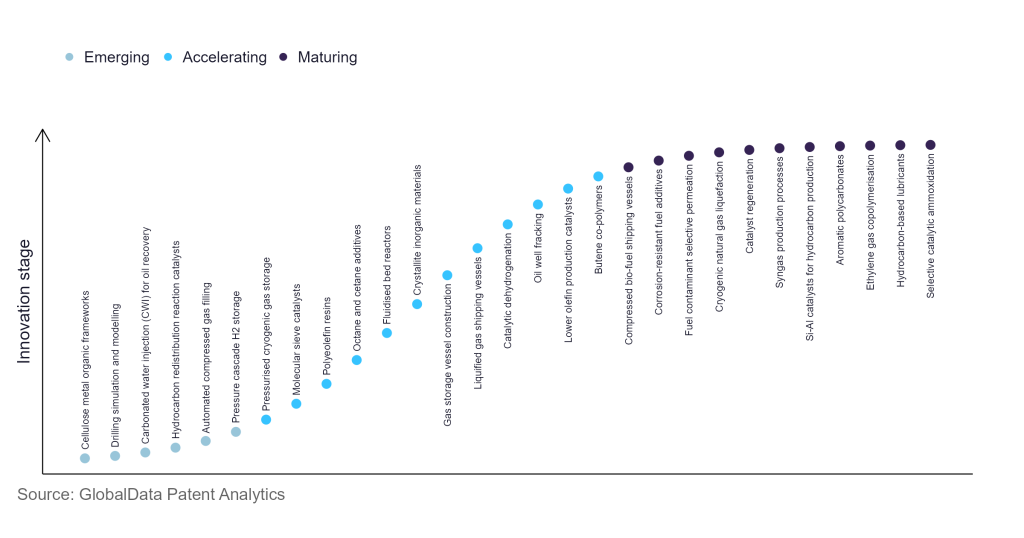The oil and gas industry continues to be a hotbed of innovation, with activity driven by an increased need for long term sustainability, the reduction of capital and operating expenses and carbon footprint, and enhancements to workforce safety. Digital technologies are enabling the oil and gas industry to achieve these objectives. This is characterised by the growing importance of technologies such as robotics, autonomous vehicles, and the internet of things. In the last three years alone, there have been over 534,000 patents filed and granted in the oil and gas industry, according to GlobalData’s report on Innovation in Oil & Gas: Automated compressed gas filling. Buy the report here.
However, not all innovations are equal and nor do they follow a constant upward trend. Instead, their evolution takes the form of an S-shaped curve that reflects their typical lifecycle from early emergence to accelerating adoption, before finally stabilising and reaching maturity.
Identifying where a particular innovation is on this journey, especially those that are in the emerging and accelerating stages, is essential for understanding their current level of adoption and the likely future trajectory and impact they will have.
40+ innovations will shape the oil & gas industry
According to GlobalData’s Technology Foresights, which plots the S-curve for the oil & gas industry using innovation intensity models built on over 256,000 patents, there are 40+ innovation areas that will shape the future of the industry.
Within the emerging innovation stage, drilling simulation and modelling, carbonated water injection (CWI) for oil recovery, and automated compressed gas filling are disruptive technologies that are in the early stages of application and should be tracked closely. Liquified gas shipping vessels and oil well fracking are some of the accelerating innovation areas, where adoption has been steadily increasing. Among maturing innovation areas are compressed bio-fuel shipping vessels and cryogenic natural gas liquefaction, which are now well established in the industry.
Innovation S-curve for the oil & gas industry

Automated compressed gas filling is a key innovation area in oil & gas
Automated compressed gas filling involves the use of robotics, sensors and data analytics for unmanned refilling of storage containers. This approach minimises the risks associated with filling of compressed gases in containers while improving productivity.
GlobalData’s analysis also uncovers the companies at the forefront of each innovation area and assesses the potential reach and impact of their patenting activity across different applications and geographies. According to GlobalData, there are 30+ companies, spanning technology vendors, established oil & gas companies, and up-and-coming start-ups engaged in the development and application of automated compressed gas filling.
Key players in automated compressed gas filling – a disruptive innovation in the oil & gas industry
‘Application diversity’ measures the number of different applications identified for each relevant patent and broadly splits companies into either ‘niche’ or ‘diversified’ innovators.
See Also:
‘Geographic reach’ refers to the number of different countries each relevant patent is registered in and reflects the breadth of geographic application intended, ranging from ‘global’ to ‘local’.
Patent volumes related to automated compressed gas filling
Source: GlobalData Patent Analytics
Linde is one of the leading companies in automated compressed gas filling. It leverages gantry robots, optical inspection technologies, automated guided vehicles, and sensor equipped-driverless forklifts to implement automated gas filling. One such commercial facility is already operational in Sydney, Australia.
To further understand the key themes and technologies disrupting the oil & gas industry, access GlobalData’s latest thematic research report on Top 20 Oil & Gas Themes 2022.
Premium Insights
From

The gold standard of business intelligence.
Blending expert knowledge with cutting-edge technology, GlobalData’s unrivalled proprietary data will enable you to decode what’s happening in your market. You can make better informed decisions and gain a future-proof advantage over your competitors.





